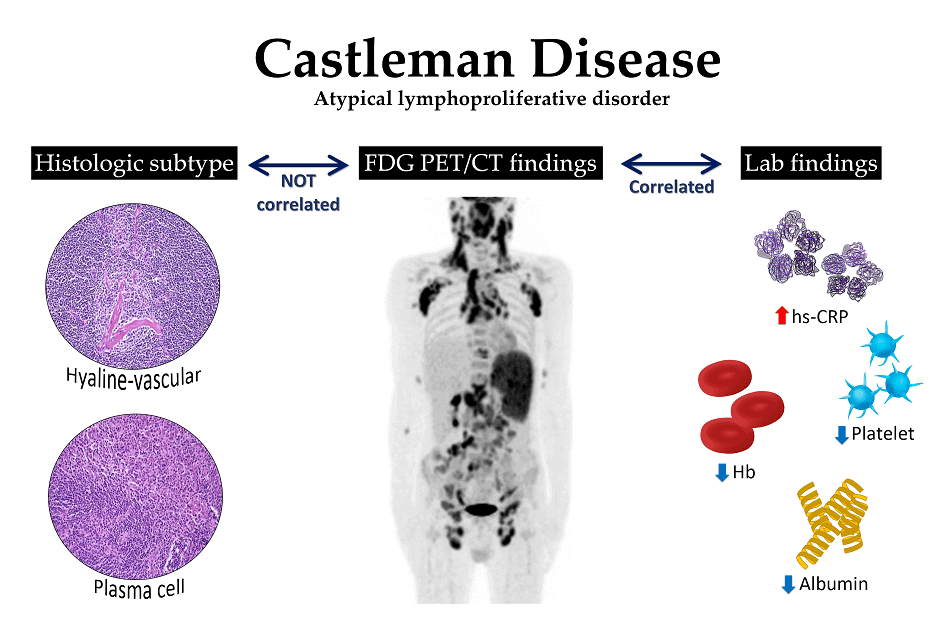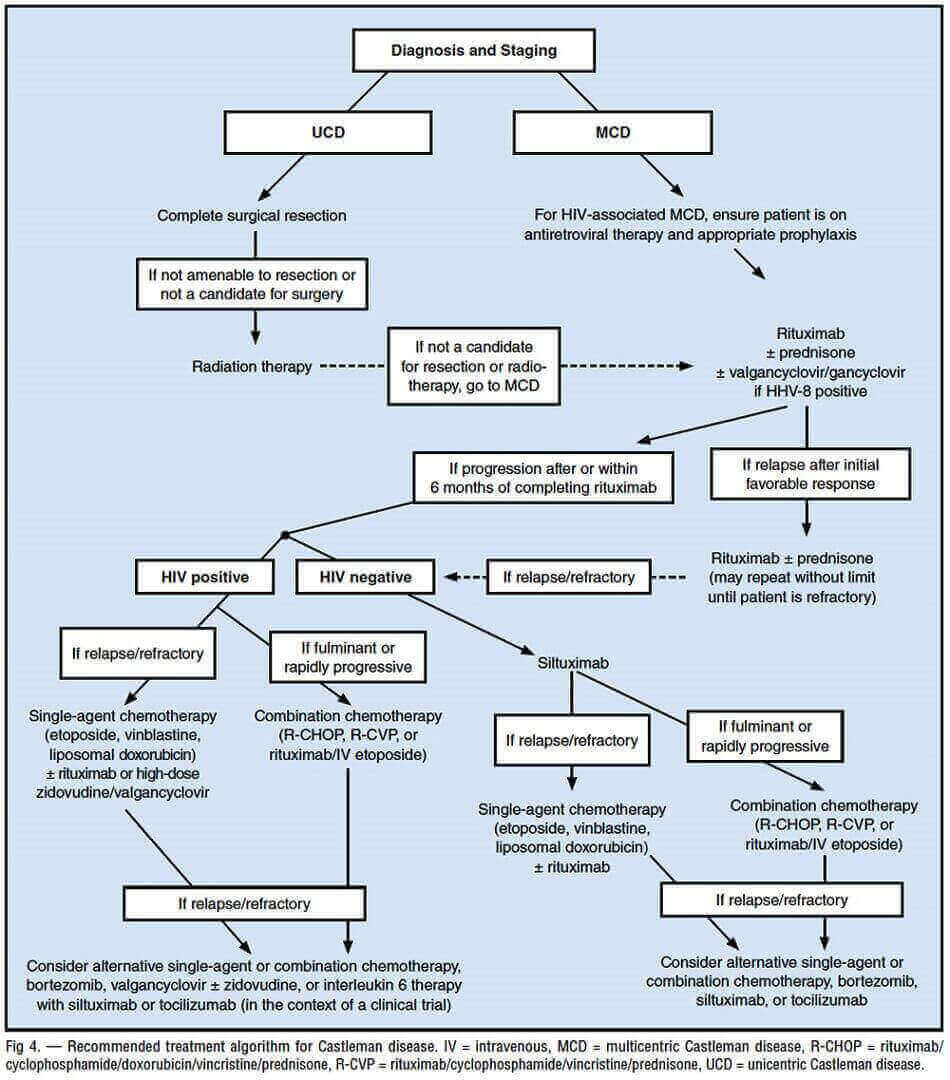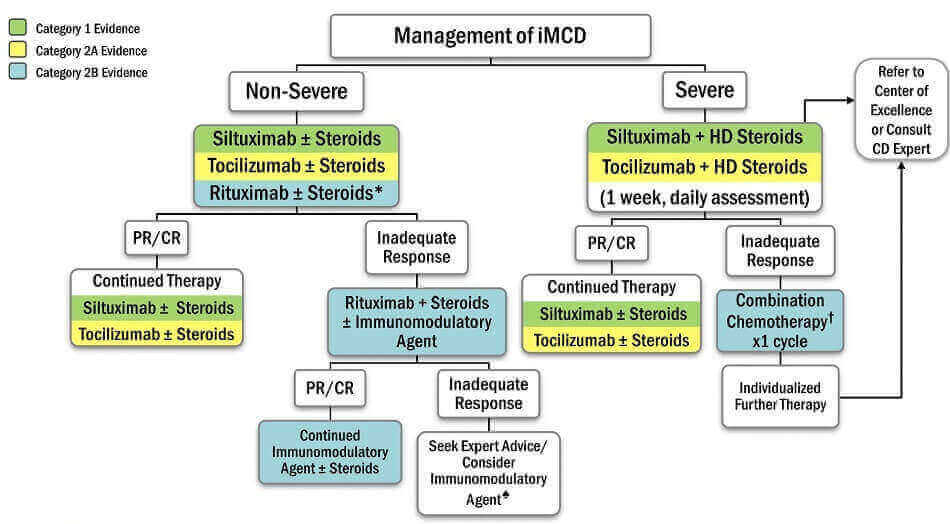Some of the Castleman disease symptoms include, but by no means are limited to fever, night sweats, anemia, fatigue, loss in appetite leading to weight loss, etc. The typical symptoms associated with the subtypes of Castleman disease are discussed extensively in this article.
Page Contents
What is Castleman’s Disease?
Castleman’s disease is a very rare, severe disease of the lymph glands. Some of the symptoms displayed by the disease are similar to that of the common flu, and it was first classified by the American pathologist Benjamin Castleman in 1956.
Castleman disease is a lymphatic disorder, in which not only the lymph glands are affected, but also the surrounding tissue.
The lymph nodes grow excessively and form tumors.
Depending on whether a single lymph node or a group of lymph nodes are affected, medicine differentiates between the most common type 1) Unicentric (localized) Castleman disease (UCD) and the more severe and rare form known as 2) Multicentric Castleman disease (MCD).
Other names commonly used for UCD are: Unicentric angiofollicular lymph hyperplasia, Unicentric angiofollicular ganglionic hyperplasia, and Localized Castleman disease

Who gets Castleman disease?
The probability of getting the disease is 1 in 100,000 every year and both sexes are affected.
The patients suffering from the severe multicentric form are generally older than those diagnosed with the unicentric form.
The unicentric type (UCD) is the more common type and shows far fewer symptoms than the multicentric (MCD) form. The single lymph node generally affected by this form of Castleman disease may be found either in the patient’s chest or belly.
The multicentric form (MCD) is usually associated with HIV (human immunodeficiency virus) and HHV-8 (human herpesvirus type 8) infections. People with HIV infection/AIDS are at an increased risk of developing this lymphatic disease. For them, the prognosis is significantly less favorable.
“Microscopic subtypes of Castleman disease
There are also four subtypes, split up by how your lymph tissue looks under a microscope.
Hyaline vascular type. This is the most common kind. It’s usually in one place. You probably don’t have many symptoms.
Plasma cell type. This is more likely to be multicentric and to cause symptoms.
Mixed type. This has areas of both hyaline vascular and plasma cell types.
Plasmablastic type. This is usually multicentric and causes symptoms.” Source
Castleman Disease Causes and Symptoms
Unicentric Castleman Disease
Unicentric Castleman Disease Causes
The causes that lead to UCD, the localized form of the disease are currently still being discussed.
Scientists assume that malignant cells in the patient’s body are responsible for the overproduction of the IL-6 (interleukin-6) substance. IL-6 is produced in the lymph nodes which help coordinating the body’s immune system’s response to infections. The overproduction may subsequently result in the overgrowth of lymphatic cells which causes the symptoms associated with UCD.
Unicentric Castleman Disease Symptoms
As mentioned, UCD, the localized type is more common and a single lymph node is affected. People with UCD may not display clinical symptoms. It is generally only discovered when a doctor is consulted for some other medical condition.
Symptoms that may occur are:
- Pressure in the chest area
- Feeling “full” in the abdominal area
- An examination may lead to the discovery of a lump underneath the skin in the neck, groin, or armpit
- Losing weight without any intent to (not on a diet to lose weight)
Multicentric Castleman Disease
Multicentric Castleman Disease Causes
MCD consists of 2 subtypes namely:
- HHV-8 (human herpesvirus 8) multicentric Castleman disease and
- HHV-8-negative or idiopathic multicentric Castleman disease.
HHV-8 (human herpesvirus 8) multicentric Castleman disease
At least 50 percent of cases are caused by HHV-8 infections found in patients who either have HIV or whose immune system is compromised for other reasons.
It is assumed that infections in the lymph nodes multiply. This subsequently leads to the release of inflammatory chemicals such as IL-6 (interleukin-6).
HHV-8-negative or idiopathic multicentric Castleman disease
The other 50% of MCD cases are referred to as HHV-8 negative or iMCD (idiopathic MCD) and the causes are unknown.
Some of the factors that are speculated upon as iMCD causes include:
- An inflammatory autoimmune disease,
- a viral infection other than Human Herpesvirus 8 (HHV-8), or
- a genetic predisposition
Idiopathic Multicentric Castleman Disease (iMCD) Symptoms
In general, the disease is associated with great pain in the affected lymph nodes. In the simpler form of the disease, the symptoms include:
- fever
- night sweats
- fatigue
- lymphadenopathy (swollen lymph nodes)
- ascites (build-up of fluids in the belly)
- hepatosplenomegaly (a condition that causes an enlarged liver and spleen)
- elevated C-reactive protein (CRP): high level of CRP in the blood is an indication of inflammation)
- hypoalbuminemia (deficit of albumin in the blood most commonly caused by acute and chronic inflammatory responses)
- anemia (insufficient red blood cells to carry oxygen to the body’s tissues).
- involuntary weight loss
- nausea
- vomiting
- loss of appetite
- a tendency to edema (swelling caused by fluid trapped in the body’s tissues)
- thrombocytopenia (low blood platelet count).
Depending on the severity and extent of the symptoms, death from multiple organ failure, severe infection and lymphoma can occur.
Castleman Disease Diagnosis
Castleman’s disease must be differentiated from lymphoma and other serious diseases in a differential diagnosis.
The severe form (MCD) in particular is often mistaken for lymphoma (cancer of the lymphatic system which includes the lymph glands, thymus gland, spleen, and bone marrow).
Using ultrasound and CT is limited to the size of the affected area. Lymph gland tissue is removed and examined histologically. Blood drawn during a disease flare-up shows elevated levels of IL-6 and CRP (C-reactive protein.
The milder form of the lymph gland disorder does not have as pronounced symptoms and lighter flare-ups. The CRP (C-reactive protein) value is lower than that of severe Castleman’s disease. The multicentric Castleman disease can develop very differently. Some patients are stable for years, in others, the disease progresses rapidly until it becomes life-threatening.
Between the attacks, the patient experiences some phases with good well-being, normal CRP (C-reactive protein) values, and even regression of the affected lymph gland tissue. However, the longer the person lives with the disease, the more frequent it comes to flare-ups and the higher the risk of developing malignant lymphoma.

Complications
Castleman’s disease causes serious complaints in the patient. There is usually severe weight loss and patients also suffer from fever or night sweats. Furthermore, pain in the stomach or abdomen is not uncommon, so that the patient’s quality of life is significantly reduced by this disease.
Castleman’s disease also causes vomiting and nausea in the patient, with loss of appetite also occurring.
The liver and spleen enlarge, which can also cause pain in the affected areas. The anemia makes those affected tired and exhausted. This disease also significantly reduces the patient’s resilience.
Without treatment, Castleman’s disease leads to organ failure and ultimately to the death of the patient.
The patient’s immune system is also weakened by the disease, making it easier for infections or inflammations to occur.
As a rule, surgery can be carried out to treat the symptoms. Furthermore, the patients are not infrequently dependent on radiation therapy. It cannot generally be predicted whether this will lead to a completely positive course of the disease. Castleman’s disease may also reduce life expectancy.
When should you go to the doctor?
If there are problems with the lymph nodes, it could be Castleman’s disease. It is recommended that you consult a doctor immediately if you experience such problems. He can decide whether it is unicentric or multicentric Castleman’s disease or another disease that affects the lymphatic system.
This relatively rare disease is associated with unspecific symptoms. Nonetheless, if it lasts for a long time, it can often not be explained by swelling of the lymph nodes caused by a cold or fever.
Persistently painful lymph nodes and the accompanying enlargement of the organs can also indicate that something might be wrong. Castleman’s disease usually occurs in episodes. This is also a signal that the cause of the swollen lymph glands must be looked for.
A visit to the doctor should not be delayed for a long time if a serious illness is suspected. Establishing Castleman’s disease requires extensive diagnostics. First of all, other diseases must be ruled out. This includes, for example, infections, autoimmune diseases, or tumorous events.
If only one lymph node is affected, it can be surgically removed. However, this is not possible with multicenter Castleman’s disease. The therapeutic range through chemotherapy, radiation, or targeted, multimodal therapeutic approaches are outlined here. The prognosis for Castleman’s disease is significantly worse, especially if there are serious immune deficiencies such as AIDS.
Castleman Disease Treatment
With unicentric Castleman’s disease, there is a good chance of a cure if the affected person has the abnormally enlarged lymph node surgically removed. The disease then only rarely comes back. If surgery is not possible, radiation therapy can be performed. The use of monoclonal antibodies against human IL-6 (siltuximab) shows good treatment results.
With the multicentric form, the prospect of successful treatment is much lower. On the one hand, this is due to the wide range of effects that interleukins 6 have on the lymph gland cells, and on the other hand because most patients with the severe form are infected with HIV and HHV-8 at the same time.
In addition, the diseased lymph nodes cannot be surgically removed because they are located in several parts of the body.
Medicine mostly treats in several ways: in anti-inflammatory therapy, corticosteroids are administered. With the help of the monoclonal antibody rituximab (either with or without ingestion of cytostatics ) the cytokine-producing interleukins 6 and 10 are contained and their signaling pathways are blocked at the same time. The symptoms are treated with special drugs (antiviral against HHV-8, anti-retroviral against HIV).

The specific prognosis for Castleman’s disease depends on the present form, the course, and the chosen treatment method. In addition, general health and the presence of other illnesses are important. The unicentric form of Castleman’s disease has a very favorable prognosis if the affected lymph node is completely surgically removed or treated with radiation therapy.
The overall survival rate for people with this form of the disease is 90 percent. A disease-free five-year survival rate is found in over 80 percent of patients. Less than five percent die of unicentric Castleman’s disease within ten years. Patients treated with chemotherapy have a slightly worse prognosis.
Due to the diverse course of the disease and the small number of cases, no concrete statements can yet be made regarding a prognosis about the multicentric form of Castleman’s disease. In general, the outlook is much worse than for patients with the unicentric form. After the standard therapy of treatment with glucocorticoids and chemotherapy, more than 50 percent of those affected suffer a relapse within three years.
Patients who also suffer from HIV have a particularly poor prognosis. Their disease-free survival after three years is 25 percent. On average, patients die 14 months after diagnosis.
Preventing Castleman Disease
Prevention against Castleman’s disease is not possible unless an infection with HHV-8, HIV, etc. is avoided in advance.
Aftercare
Follow-up care for Castleman’s disease primarily relates to the possible preventive measures. It also includes the treatment of emotional distress. Patients need trustful support from family members and friends. After completing the first therapy, physical activity helps to strengthen the body.
The effort should remain in the easy to moderate range. In this way, they strengthen the immune system and improve the health prognosis. Endurance sports or water aerobics are ideal sports. Breathing therapy can also help to optimize wellbeing. In addition, eating as healthy as possible is helpful.
For the recovery process, it makes sense to seek help from a doctor or nutritionist. Of course, regular check-up appointments with the responsible doctor must also be observed. In this way, possible complications can be identified at an early stage. If necessary, the doctor takes special measures to prevent the condition from worsening.
Direct prevention against the disease is currently not possible. Patients can only step up protective measures against HIV infection. Psychological support can also have a positive effect on well-being.
Conclusion
If Castleman’s disease is diagnosed, it is sometimes a great emotional burden for those affected. The most important self-help measure consists of talking to friends, relatives, and other affected persons.
After therapy, the body should be carefully observed. If there are signs of a relapse or other complications arise, the doctor should be informed. In case of doubt, you must go to the nearest hospital with the complaints so that the necessary measures can be taken immediately in the event of serious complications that may arise in the first few months after the end of therapy.
